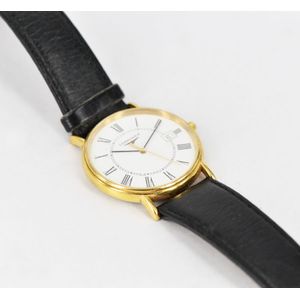Limited Edition Omega Speedmaster MIR Space Station Watch
A gentleman's stainless steel MIR Space Station Speedmaster wristwatch, Omega, circa 1993. Manual. 42 mm. Ref: 145.0022. Cal.861. Case number 48294621. Number 19 of 28. Black dial, tritium baton numerals. Case, dial, and movement signed. Velcro flight strap. Original aluminium presentation case, warranty card, certificate, biro, book, and video. Notes: This important watch is part of a very limited edition release, one of thirty-five watches which spent twelve months aboard the Space Station MIR between July 1993 and 1994. Each watch was transported aboard the Soyuz-TM launch rocket with each certificate witnessed by the crew of this mission. 28 of the original 35 were offered for sale in 1995. In the context of collectable Omega Speedmaster moon watches, this watch is potentially among one of the rarest references in existence
You must be a subscriber, and be logged in to view price and dealer details.
Subscribe Now to view actual auction price for this item
When you subscribe, you have the option of setting the currency in which to display prices to $Au, $US, $NZ or Stg.
This item has been sold, and the description, image and price are for reference purposes only.
- Baton Numerals - A watch that instead of displaying numerals on the face, displays a marker in the form of a baton, or lower case letter "L". Since the baton-like marks are not numerals, the feature is also called baton markers, baton indexes and baton indicators.
- Circa - A Latin term meaning 'about', often used in the antique trade to give an approximate date for the piece, usually considered to be five years on either side of the circa year. Thus, circa 1900 means the piece was made about 1900, probably between 1895 and 1905. The expression is sometimes abbreviated to c.1900.
- Moon Dial - If we imagine life in the 17th century, the only source of ascertaining the time of day or night would have been the local church or municipal clock striking every quarter hour, and able to be heard by all in the village. In England, when longcase clocks became popular and more affordable in the late 17th century, the function of timekeeping and source of time was moved to within the home.
An additional feature on some longcase clocks was to display the phases of the moon, that is the new moon, the full moon and the waning moon over the lunar 29 ½ day cycle. This information was important for farmers for working out cropping schedules; for travellers to know the amount of moonlight on a night they planned to travel; and for those who lived near the sea required knowledge of the tides.
Where included, the moon dial is usually in the form of a disc incorporated into the main dial plate, usually in the arched top section. The lunar cycle starts with the new moon displaying, which is a dark night sky and no man-in-the-moon face being displayed, and then progresses to the full moon face showing on the 15th day of the lunar cycle, and back to no face displaying as the moon wanes. Most lunar dials are partially concealed on each side of their opening in the main dial plate by semi-circular "humps" that allow the painted face to emerge slowly just as the real moon goes out of and back into the earth's shadow.
Nowadays, details of the lunar cycle is published in diaries, almanacs, and newspapers and although some modern longcase clocks are still manufactured with working moon dials, they are more for decoration than for use. - Movement - The technical name for the workings of a clock or watch, and does not include the dial or case.
This item has been included into following indexes:
Visually similar items

Gentlemen's watch marked Rolex good quality replica (new)
Sold by
in
for
You can display prices in $Au, $US, $NZ or Stg.

'La Grande Classique' Longines Ladywatch, white dial, date, gold plated case, Swiss quartz movement, black leather bracelet, model L4.636.2, numbered 27494992.
Sold by
in
for
You can display prices in $Au, $US, $NZ or Stg.

A Lanvin Ladywatch, white dial, date, Swiss quartz movement, gold plated case with black leather bracelet, numbered 519445.
Sold by
in
for
You can display prices in $Au, $US, $NZ or Stg.

Men's Seiko watch, 70m automatic, 6119-8460, Gene Kranz
Sold by
in
for
You can display prices in $Au, $US, $NZ or Stg.
